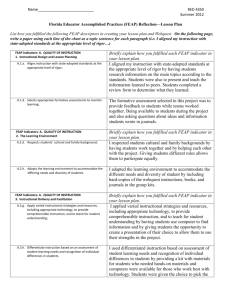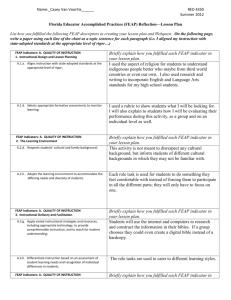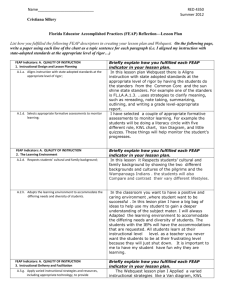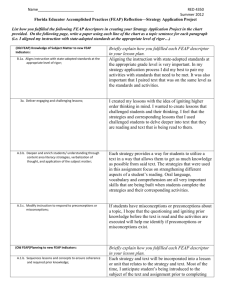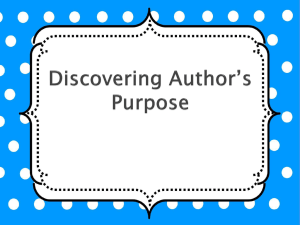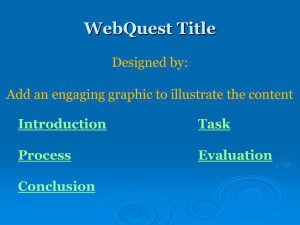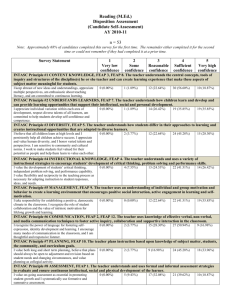Webquest_Lesson_Plan_FEAPs
advertisement
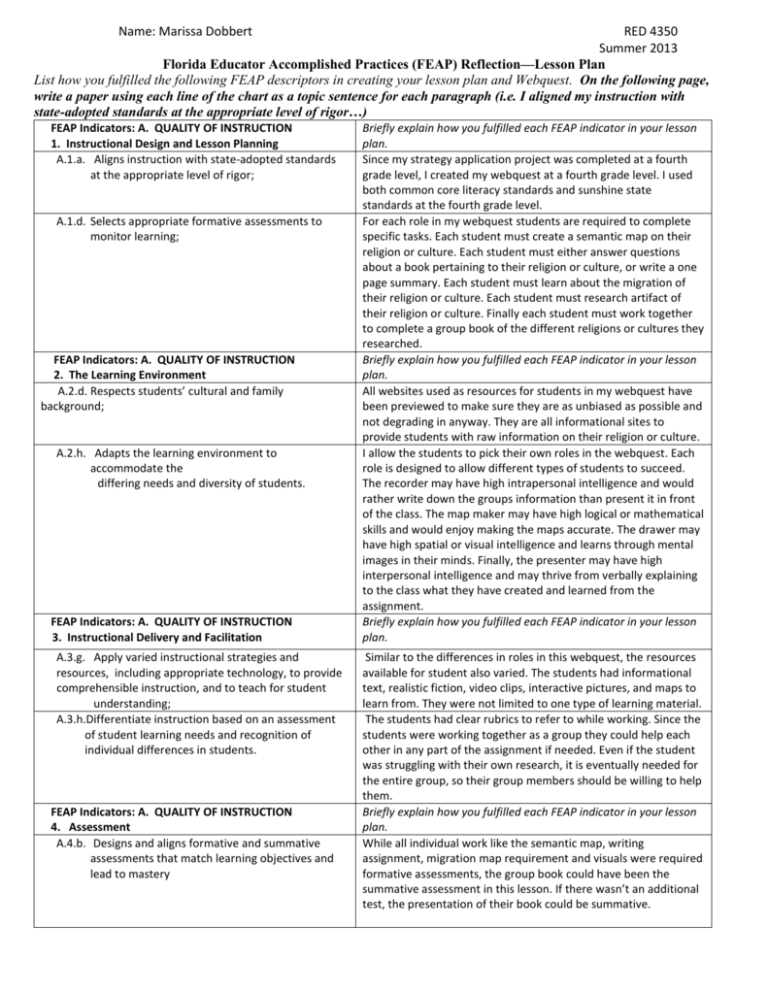
Name: Marissa Dobbert RED 4350 Summer 2013 Florida Educator Accomplished Practices (FEAP) Reflection—Lesson Plan List how you fulfilled the following FEAP descriptors in creating your lesson plan and Webquest. On the following page, write a paper using each line of the chart as a topic sentence for each paragraph (i.e. I aligned my instruction with state-adopted standards at the appropriate level of rigor…) FEAP Indicators: A. QUALITY OF INSTRUCTION 1. Instructional Design and Lesson Planning A.1.a. Aligns instruction with state-adopted standards at the appropriate level of rigor; A.1.d. Selects appropriate formative assessments to monitor learning; FEAP Indicators: A. QUALITY OF INSTRUCTION 2. The Learning Environment A.2.d. Respects students’ cultural and family background; A.2.h. Adapts the learning environment to accommodate the differing needs and diversity of students. FEAP Indicators: A. QUALITY OF INSTRUCTION 3. Instructional Delivery and Facilitation A.3.g. Apply varied instructional strategies and resources, including appropriate technology, to provide comprehensible instruction, and to teach for student understanding; A.3.h.Differentiate instruction based on an assessment of student learning needs and recognition of individual differences in students. FEAP Indicators: A. QUALITY OF INSTRUCTION 4. Assessment A.4.b. Designs and aligns formative and summative assessments that match learning objectives and lead to mastery Briefly explain how you fulfilled each FEAP indicator in your lesson plan. Since my strategy application project was completed at a fourth grade level, I created my webquest at a fourth grade level. I used both common core literacy standards and sunshine state standards at the fourth grade level. For each role in my webquest students are required to complete specific tasks. Each student must create a semantic map on their religion or culture. Each student must either answer questions about a book pertaining to their religion or culture, or write a one page summary. Each student must learn about the migration of their religion or culture. Each student must research artifact of their religion or culture. Finally each student must work together to complete a group book of the different religions or cultures they researched. Briefly explain how you fulfilled each FEAP indicator in your lesson plan. All websites used as resources for students in my webquest have been previewed to make sure they are as unbiased as possible and not degrading in anyway. They are all informational sites to provide students with raw information on their religion or culture. I allow the students to pick their own roles in the webquest. Each role is designed to allow different types of students to succeed. The recorder may have high intrapersonal intelligence and would rather write down the groups information than present it in front of the class. The map maker may have high logical or mathematical skills and would enjoy making the maps accurate. The drawer may have high spatial or visual intelligence and learns through mental images in their minds. Finally, the presenter may have high interpersonal intelligence and may thrive from verbally explaining to the class what they have created and learned from the assignment. Briefly explain how you fulfilled each FEAP indicator in your lesson plan. Similar to the differences in roles in this webquest, the resources available for student also varied. The students had informational text, realistic fiction, video clips, interactive pictures, and maps to learn from. They were not limited to one type of learning material. The students had clear rubrics to refer to while working. Since the students were working together as a group they could help each other in any part of the assignment if needed. Even if the student was struggling with their own research, it is eventually needed for the entire group, so their group members should be willing to help them. Briefly explain how you fulfilled each FEAP indicator in your lesson plan. While all individual work like the semantic map, writing assignment, migration map requirement and visuals were required formative assessments, the group book could have been the summative assessment in this lesson. If there wasn’t an additional test, the presentation of their book could be summative. Name: Marissa Dobbert RED 4350 Summer 2013 I aligned instruction with state-adopted standards at the appropriate level of rigor. Since my strategy application project was completed at a fourth grade level, I created my webquest at a fourth grade level. I used both common core literacy standards and sunshine state standards at the fourth grade level. I selected appropriate formative assessments to monitor learning because for each role of my webquest students are required to complete specific tasks. Each student was required to create a semantic map on their religion or culture. Each student had to either answer questions about a book pertaining to their religion or culture, or write a one page summary. Each student was required to learn about the migration of their religion or culture. Each student needed to research artifact of their religion or culture. Finally each student had to work together to complete a group book of the different religions or cultures they researched. Throughout this assignment I respected student’s cultural and family background because all websites used as resources for students in my webquest have been previewed to make sure they are as unbiased as possible and not degrading in anyway. They are all informational sites to provide students with raw information on their religion or culture. I was sure to adapt the learning environment to accommodate the differing needs and diversity of students. In my webquest I allow the students to pick their own roles in the webquest. Each role is designed to allow different types of students to succeed. The recorder may have high intrapersonal intelligence and would rather write down the groups information than present it in front of the class. The map maker may have high logical or mathematical skills and would enjoy making the maps accurate. The drawer may have high spatial or visual intelligence and learns through mental images in their minds. Finally, the presenter may have Name: Marissa Dobbert RED 4350 Summer 2013 high interpersonal intelligence and may thrive from verbally explaining to the class what they have created and learned from the assignment. Throughout the lesson I applied varied instructional strategies and resources, including appropriate technology to provide comprehensible instruction and to teach for student understanding. Similar to the differences in roles in this webquest, the resources available for student also varied. The students had informational text, realistic fiction, video clips, interactive pictures, and maps to learn from. They were not limited to one type of learning material. I used differentiated instruction based on an assessment of student learning needs and recognition of individual differences in students. The students had clear rubrics to refer to while working. Since the students were working together as a group they could help each other in any part of the assignment if needed. Even if the student was struggling with their own research, it is eventually needed for the entire group, so their group members should be willing to help them. Finally I designed and aligned formative and summative assessments that matched learning objectives and lead to mastery. While all individual work like the semantic map, writing assignment, migration map requirement and visuals were required formative assessments, the group book could have been the summative assessment in this lesson. If there wasn’t an additional test, the presentation of their book could be summative.
